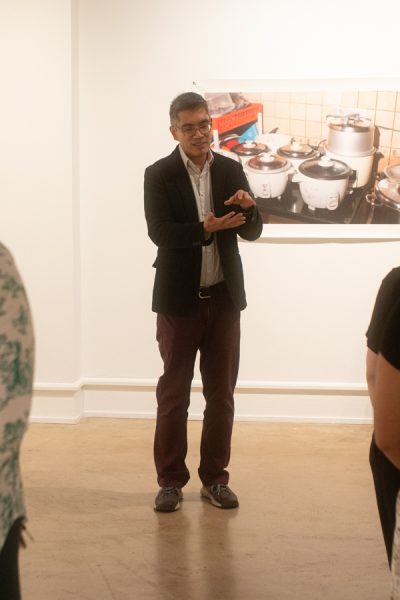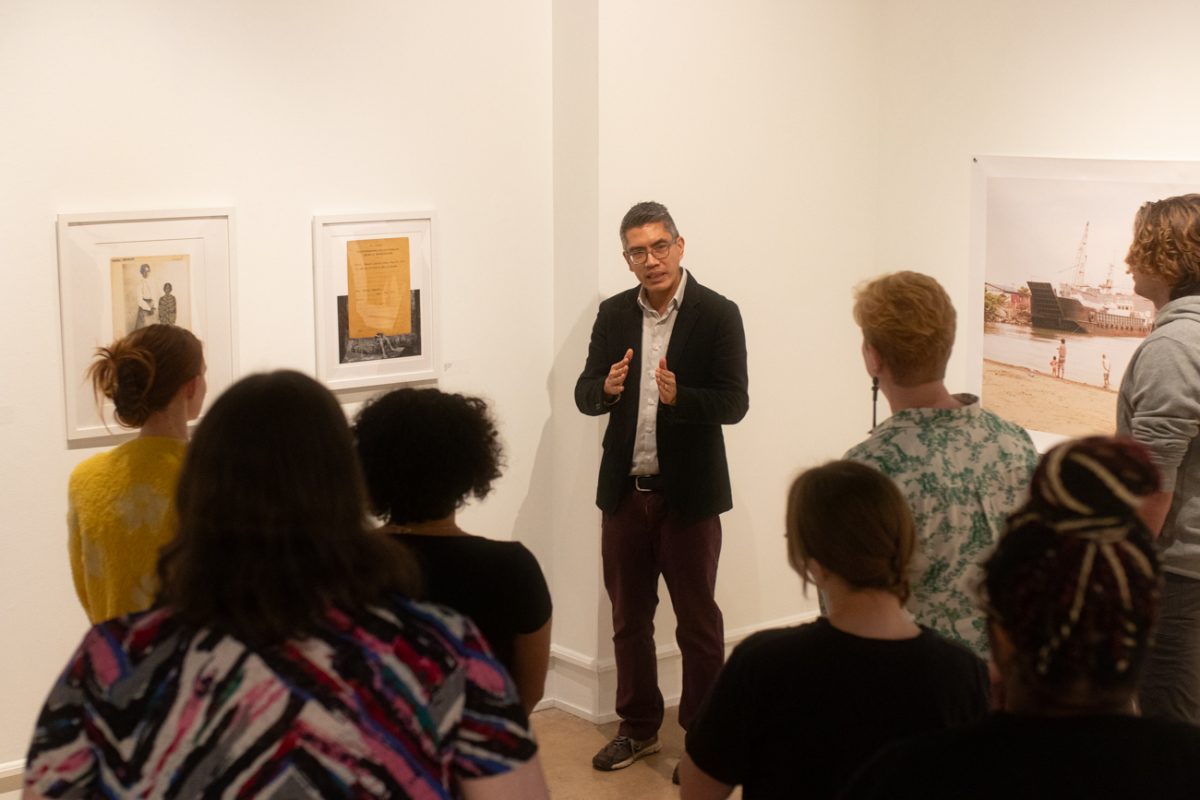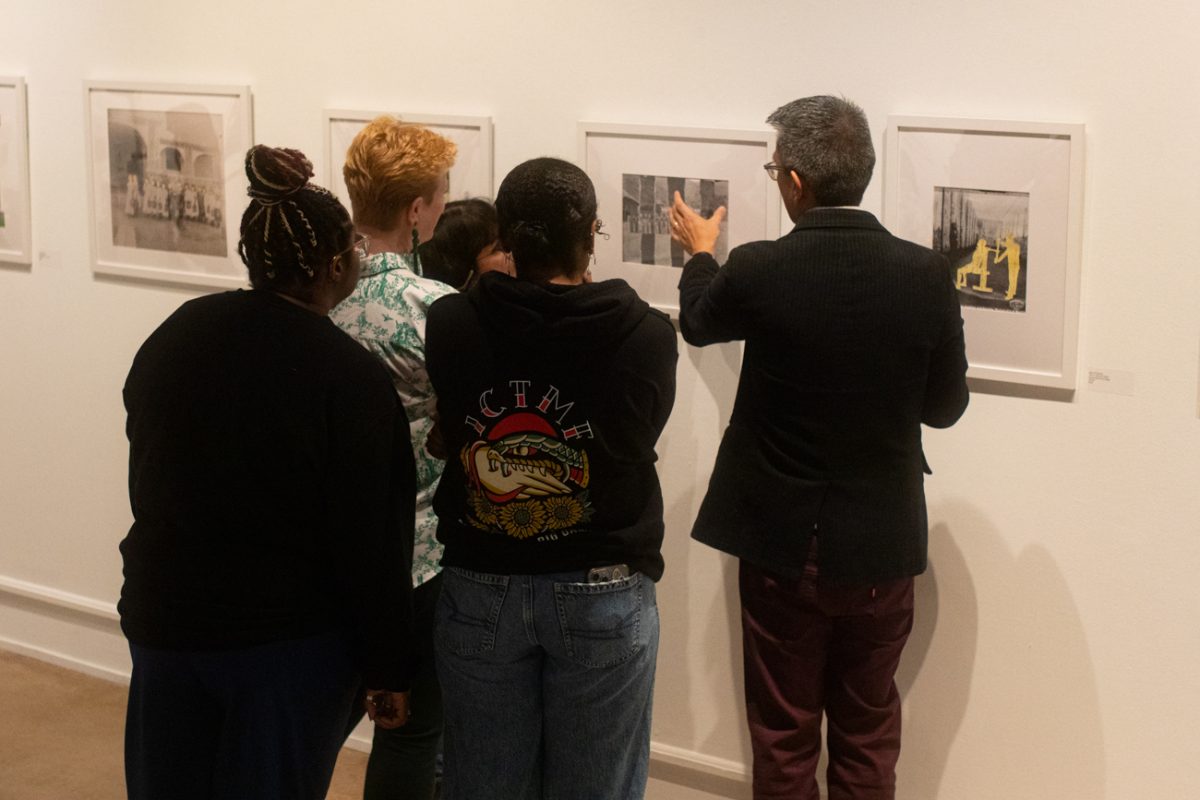Art is made to challenge standards and evoke questions. Depictions of colonization have often been photographed through the lens of Americans, but what if those roles were reversed?
Last week, Jason Reblando visited Wichita State University to talk about his recent project, “This Is Captured Paper.”
The exhibit, now displayed in the McKnight Art Center, focuses on reframing images from the colonial era of the Philippines and Filipino culture in different countries, following Reblando as he connects with his heritage.
In a separate project within the same exhibit, Reblando uses colonial photographs from the Philippines and photos he took of Filipino migrants during his travels to display a variety of collages.
“All the pieces come back to three overlapping themes of colonization, photography and its expanding portability and accessibility, and the forensic desire to document colonized people,” Reblando said. “Photography is a wonderful thing but really, (it) can be yielded as a tool of power.”
Migration in the Philippines
Reblando was raised in New York and hadn’t visited the Philippines until he was in his 30s when he received a U.S. Fulbright Fellowship. During his time in the Philippines, he learned about the large number of Overseas Filipino Workers (OFW), who are migrants working abroad. Many of Reblando’s pieces attempt to capture the life of OFWs and how they stay connected to their families and culture.
“There’s no incentive for the government to stop this flow (of people leaving the country) if you have this revolving door of people that are willing to leave their families,” Reblando said. “And there’s no attempt to really put in the work to improve things at home (in the Philippines).”
Due to the large number of people who leave the country as OFWs, many Filipinos search for ways to create a community abroad to connect with their home country. Reblando has a large collection of photographs that portray these communities all around the world.

Some of the pictures show Filipinos connecting to their culture by gathering on their days off from work, buying grocery items that they send home to their families, or cooking food from their home country. One photograph in particular titled “Eight Roommates” shows eight rice cookers sitting on a counter being used by eight Filipino roommates in Dubai.
Reblando also spoke about his previous projects including “Outside Public Housing” and “New Deal Utopias” where he photographed communities that were going to be displaced due to public housing being destroyed or changed into mixed-income developments. This links to his current projects by focusing on how communities have been fractured by government interference.
“I zoomed out geographically and conceptually, and I was looking for metaphors and surrogates for the utopian aspirations of the planners,” Reblando said. “Also the attempts to create a perfect world … every utopia needs to have a border or a break with the past and here pioneers our attempt to create a new world.”
Decolonization through art
As Reblando discovered more about his culture, he said he also realized how his passion and career were used to dehumanize his people.
After the Spanish-American war, in which the Philippines aided the U.S., Filipino kindness was returned by having their old oppressors replaced with brand new ones, Reblando said During this period, photography was used to paint the Filipino people as savages and brutes in need of saving by way of colonization and assimilation.
“I contemplate not only how the long shadow of colonization affects people’s lives today, but how photography has cemented perceptions of the Philippines as a primitive society,” Reblando said.
While Reblando’s work doesn’t aim to change history, it does aim to inform the viewer on the proper context of that history, as well as properly reshaping the perceptions propagated by traditionally white photographers.
“I’m not a historian, but history informs my practice, nor am I an archivist, but the archive is a source of inspiration and reflection,” Reblando said.
Reblando highlights this in his exhibit through a collage entitled “We Speak English.”
The collage shows several young Filipino girls with their faces blocked out with gold spots holding signs. Each sign has a letter on it spelling out “We speak English.” Reblando uses the striking visual to show who colonization has affected the most.
The people who suffered the most under colonization were not those who were already firm in their identities — but those who were robbed of it, Reblando said.
When addressing an audience, Reblando talked about one specific image in which he thought he had finally found a picture that didn’t paint the Filipino people in a bad light.
It was a picture of a young Filipino boy standing next to an older white lady. The collage Reblando made had the boy’s faces obscured because, upon further investigation, Reblando found the caption of the photo remarked about how the boy was almost “fully civilized.”
When describing how he felt after reading the caption, Reblando was moved to tears, saying he felt the need to protect the boy in some way.
“Seeing these images over and over again as far as the subjectification and subjugation recorded,” Reblando said. “It’s just hard to see that while identifying with the people, feeling like they’re stuck in the background.”
Reblando said “This is Captured Paper” demonstrates how photography can be used to capture beauty or as a tool of oppression. When a photographer takes a photo, they subject the viewers to see the world through their eyes. And when you see the colonized through the eyes of their colonizers, Reblando said, it paints a pretty skewed picture.
Reblando flips this picture on its head and expose for what it really is: a misrepresentation of his people and their culture.









JL de Grasse • Feb 10, 2025 at 4:12 pm
Thank you for covering this presentation for those of us who were unable to attend!
Winona Pasimio • Feb 7, 2025 at 7:31 pm
Congratulations, Jason! I’m so proud of the work you’re doing! Keep it up!